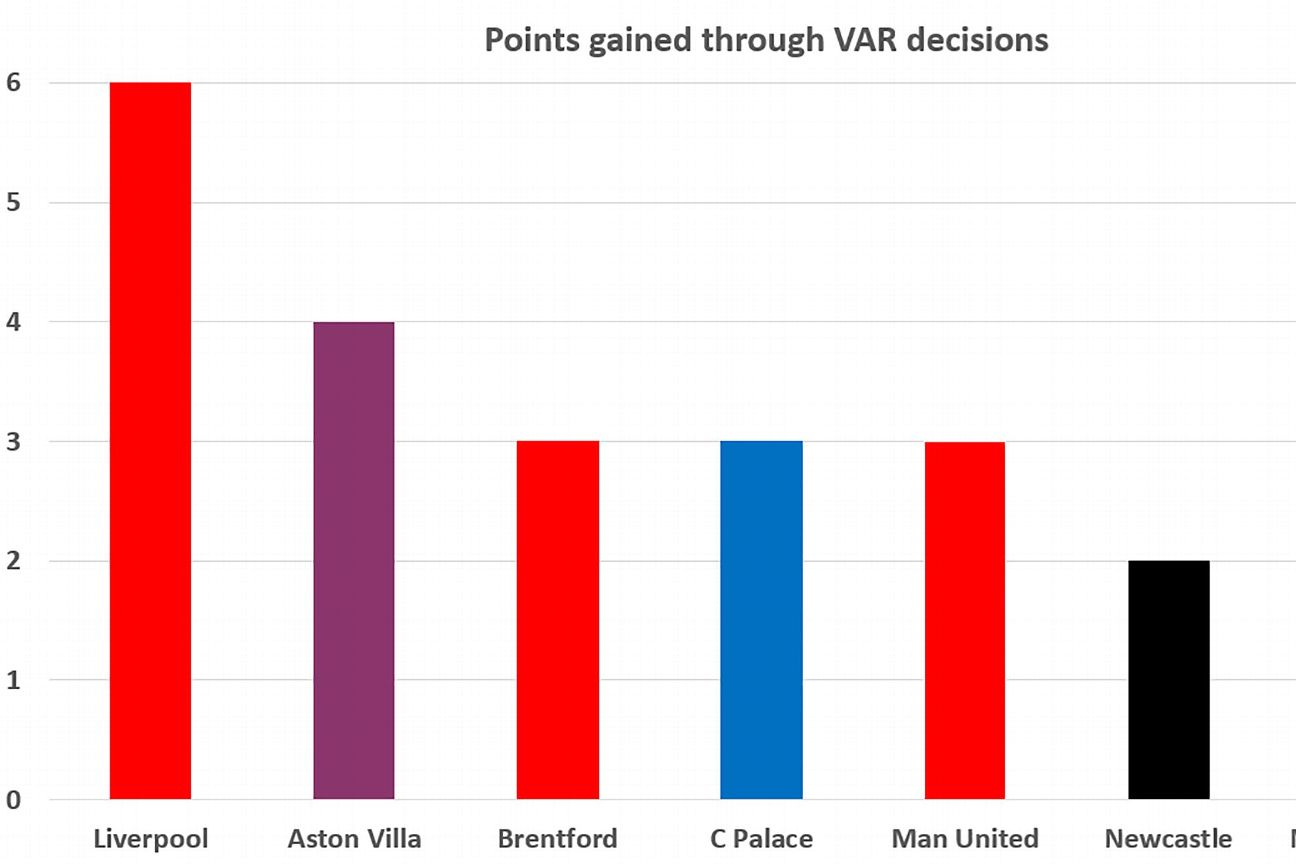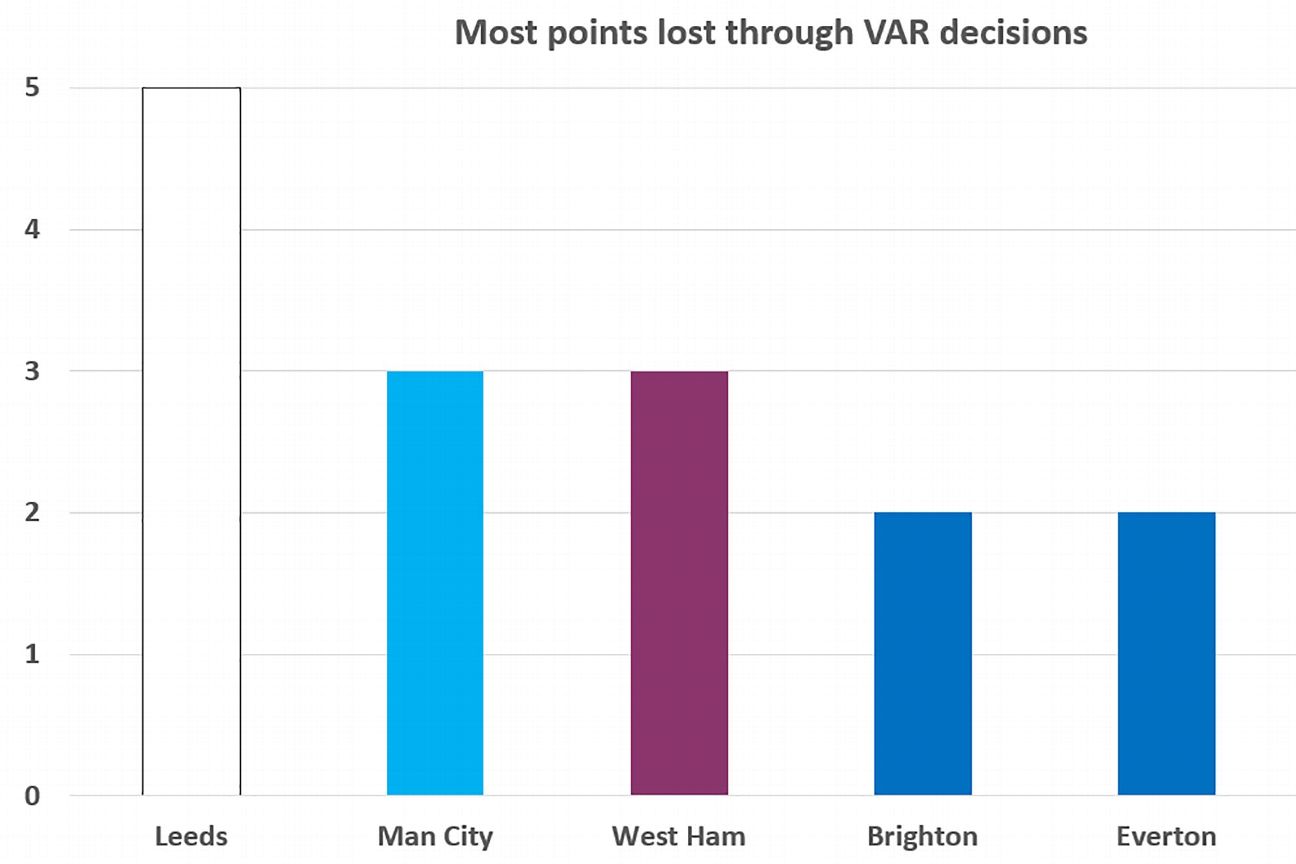The 2022-23 Premier League season is just past the halfway point, 199 games old, and it’s fair to say it’s been a season to forget for Jurgen Klopp and Liverpool. But it could have been a lot worse if they hadn’t had a series of key VAR decisions go in their favour.
– Stream on ESPN+: LaLiga, Bundesliga, more (U.S.)
Liverpool have seen four goals disallowed for their opponents by the VAR, more than any other club, and two of those came at crucial times and were potentially result-changing; the Reds were also awarded a goal when 2-0 down in a game they went on to draw.
Last season, our VAR Effect Table showed that Arsenal would have qualified for the Champions League in place of arch-rivals Tottenham Hotspur if it hadn’t been for VAR. The Gunners have more points without VAR this season too, and would actually still be on course to emulate the “Invincibles” of 2003-04 with an unbeaten record. But they are no longer five points clear of Manchester City at the summit.
Like we did last season, we’re looking at all VAR decisions across the Premier League, and seeing how they might have affected the outcome of games.
It’s not just about the number of times a team gets a favourable VAR call or about how many goals are affected. What’s more important is when these VAR decisions take place and, crucially, whether that impact would ultimately have changed the final score.
Crucially, we’re not saying the VAR decisions were wrong — we’re just looking at what might have happened if the video assistant didn’t exist and the original decisions stood.
ESPN brings you the VAR Effect Table. We’ve taken all 61 VAR overturns in the Premier League so far this season and calculated how they might have influenced matches. We’ll continue to track VAR throughout the season and find out who the true winners and losers are.
– JUMP TO: The losers without VAR | The winners without VAR
How we work out the VAR Effect Table
We take only the first VAR overturn in each game, because the calculation considers that any subsequent VAR incident wouldn’t have happened because the whole direction of the game has been altered. (Think of it like a Marvel timeline, or the plot of any time travel movie.)
The VAR decision is then reversed to the original on-field call — so if a goal is disallowed for offside, it’s given as a goal.
If a penalty has been cancelled, it is considered to have been awarded and scored, unless the team in question has a penalty-conversion record below 50% over the season. For instance, Crystal Palace have failed to score from the penalty spot, missing both spot kicks. If below 50%, a penalty may be judged to have been missed.
If a team has been awarded a goal through a penalty or an incorrect offside through VAR, the goal is disallowed.
We then take into account a series of factors before settling on a predicted outcome:
Team form: Results in the previous six matches give an indication of how a team has been playing generally.
Time of incident: For instance, if an incident happens late in the game, it’s less likely that the scoreline would change again after this point.
xG at time of incident: This allows us to take into account which team has been creating the better chances and is in the ascendancy.
Team strength: As well as form, a team’s general strength plays a part. This takes into account league position, and a team’s goal-scoring and defensive records across the season.
Impact of incident: For example, a red card decision being reversed may change the outcome of a match.
These results have then been used to modify the table and work out what impact VAR has had on teams’ positions this season.
The table shows each team’s position after the amended results, with the arrows indicating if their league position is better or worse without VAR. Not all teams have played the same number of games due to postponements.
The big losers without VAR
Liverpool have been, by some distance, the biggest beneficiaries of VAR decisions at key times this season. In fact, without the intervention of the video assistant referee they would be six points worse off. While they may only drop two places in the table (still the joint most) into 11th, they now sit just six points above the relegation zone and 14 adrift of the Champions League places. The Reds are firmly in midtable mediocrity, and even nine points behind seventh-placed Fulham in the last possible European slot.
One huge VAR decision came in October when Phil Foden had a goal disallowed at Anfield, with Erling Haaland having fouled Fabinho. It was goalless early in the second half, and Liverpool went on to win 1-0. With Manchester City in excellent form at the time, Pep Guardiola’s men are taken to have gone on and win the game from that Foden goal, so Liverpool lose three points in the VAR table.
A couple of weeks before, Liverpool were 2-0 down at home to Brighton when Mohamed Salah had a goal disallowed for offside, until the VAR stepped in to award it. That let Liverpool back into the game, which finished 3-3; but our table gives a Brighton win without that VAR intervention, costing Liverpool another point.
In September, Conor Coady had what would have been a later winner disallowed for offside in the Merseyside derby and, as recently as last week, Chelsea had a goal disallowed for offside against Kai Havertz when the game was goalless. Those two draws become defeats, giving a total of six points; no VAR intervention in a Liverpool game has cost them points.
Aston Villa are next on the list — but even though they lose four points, remarkably they actually climb a place into the top half of the table as Liverpool fall below them. Villa’s gains both came only this month, first Emiliano Buendia had a goal awarded for an incorrect offside against Leeds United in a game which finished 2-1. Two weeks later, Southampton‘s James Ward-Prowse had a goal disallowed for a foul in the buildup that would have given Saints the lead, in a match Villa went on to win 1-0. Both games become draws.
Manchester United drop out of the Champions League places, falling one place to fifth. Erik ten Hag’s team are three points worse off, with their 3-1 win at home to Arsenal becoming a loss. The game was 0-0 when Gabriel Martinelli had a goal ruled out for a foul in the buildup by Martin Odegaard, a decision which has since been confirmed as one of six VAR mistakes in the first half of the season. The Gunners are predicted to have gone on to win that game after scoring the first goal. It’s the only Man United result changed by a VAR intervention.
Fellow Champions League-chasers Newcastle United have a net goal score of +3 through VAR, a tally which is only bettered by Liverpool, and when those decisions are removed they lose two points — but still hold onto fourth. The Magpies have been one of the most active clubs, with eight VAR overturns. They’ve lost points through VAR thanks to a disallowed goal against Crystal Palace, but have gained far more from decisions in their favour against Bournemouth, Fulham and Wolves.
Brentford, who have had the most goals awarded (three) through VAR but have also had three disallowed, are three points worse off and drop one place into ninth. Key results changed are a win against Leeds becoming a draw, and a draw at Nottingham Forest now a loss.
Crystal Palace lose three points too, dropping two places into 14th, with Nottingham Forest a point worse off, down two to 15th.
Chelsea are unchanged on 29 points; though the offside decision went against them at Liverpool, West Ham had a last-minute equaliser disallowed at Stamford Bridge. Despite being on the same points, the Blues still climb two places into eighth due to the deductions for Brentford and Liverpool.

The big winners without VAR
Arsenal are enjoying a five-point cushion at the top of the Premier League table, yet without VAR, that would be cut to three points. And that’s not because VAR has worked in their favour, quite the opposite as the Gunners are one point better off — but Manchester City have actually been worse affected.
While that defeat to Man United comes a 2-1 victory for Arsenal, giving them an additional three points, the 1-0 win at Leeds United is now a draw after an injury-time penalty to the home side was cancelled through a VAR decision. But Pep Guardiola’s team get three additional points, courtesy of the loss to Liverpool becoming a victory.
There’s also an improvement for Antonio Conte’s Tottenham Hotspur, who climb above both Newcastle and Man United into third in the table; while their rivals drop points, Spurs are up by two. They have only been involved in four VAR overturns, the key one being their cancelled penalty at West Ham, in a game which finished as a 1-1 draw.
The biggest winners without VAR are actually Leeds United, who get five points and climb three places into 12th — six points above the relegation zone and level with Liverpool. Leeds have conceded four goals through VAR, more than any other team. As well as the gained draw against Arsenal, they are given a win at home to West Ham and draws from defeats at Aston Villa and Brentford. Jesse Marsch’s side haven’t had a VAR decision which has led to an improved final scoreline.
West Ham United also climb away from the bottom of the table, up three points and places into 13th. Though they lose a point against Leeds and Spurs, they gain one each from draws at Chelsea and Forest. West Ham’s 2-1 home loss to Crystal Palace, when they had a late penalty cancelled when the score was still 1-1, becomes a victory.
Brighton & Hove Albion (two points) and Fulham (one point) are better off without VAR, but remain unchanged in sixth and seventh respectively.

Of the five teams now at the foot of the table, four have a higher points total.
The only team unchanged are Wolverhampton Wanderers, and that sees them overtaken and drop into the relegation zone, falling from 17th to 19th. Everton improve by two points and move up one spot into 18th; Leicester City get one additional point, but fall into 16th as West Ham climb above them; AFC Bournemouth are up a point, taking them out of the bottom three into 17th.



